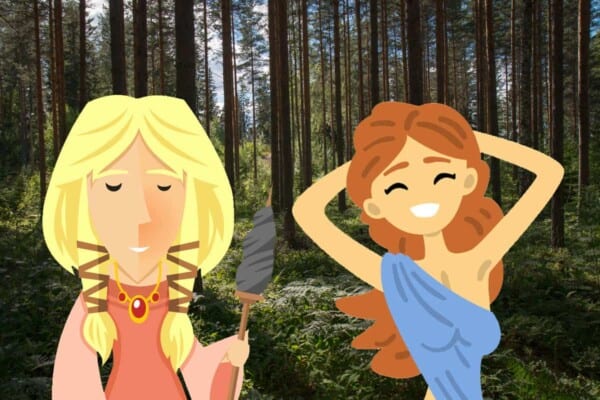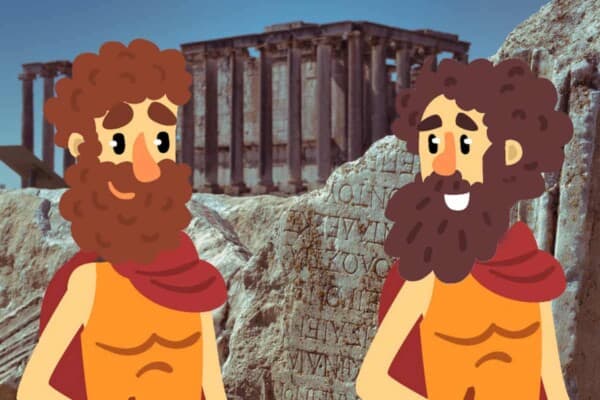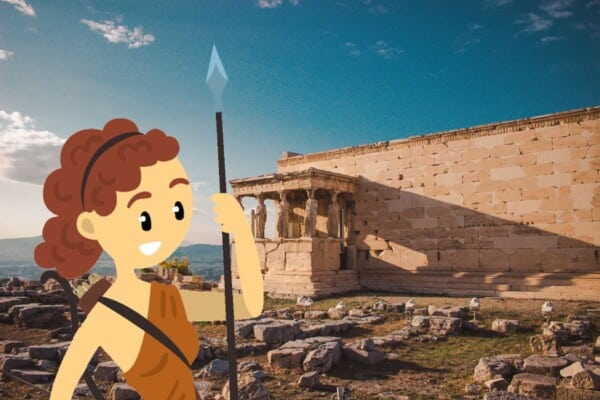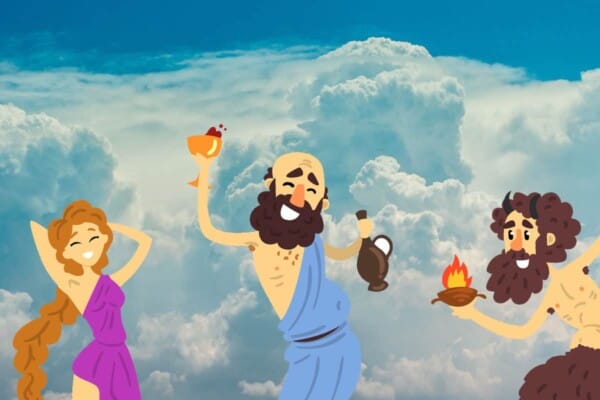The story of Pygmalion and Galatea is as old as time itself. It is a story that we can see being reinterpreted even to this day, which is a testament to how well written it was all those years ago.
But what exactly is this story and what can we learn from it? After all, we know that the main reason why ancient Greek stories lasted for so long is because they are not only entertaining, but they also do serve as cautionary notes left behind for the people to follow.
So, let’s dive right into this story, starting of with a little introduction to the characters that we’re about to check up on together:
The Story of a Lone Sculptor and His Creation
The mere image of Pygmalion became quite prevalent in Cyprus back in the day, as he served as a very good depiction of how a lot of young men at the time felt.
The story goes as follows, as the man named Pygmalion does his bidding, working as a sculptor in Cyprus just trying to make a living. He is just like any other man; he does his job and he hopes to eventually find the right one for him so that they may spend their lives together.
The problem comes when he sees the daughters of Propoetus, the Propoetides, prostituting themselves for money. Upon seeing this image, he shuns at the idea of finding the right one for him.
He believes from this moment on that women are nothing but prostitutes, and he decides that he will never get married with any after all.
When he gets home though, still feeling angry at the situation, he decides to create his perfect depiction of a woman, since he was a really talented sculptor after all.
He uses ivory to bring her to life in front of him, figuratively speaking, and as soon as he finishes his job, he can’t help but fall in love with her due to how real and beautiful she looks. She is the perfect idea of a woman for him, especially since she is untainted by the streets, as the Propoetides were.
Soon after though, Aphrodite’s festival day comes, and everybody rejoices. During this festival, you are supposed to make an offering and pray to the Goddess of Love in the hopes that you will find the one for you soon enough.
Despite his love for his creation, Pygmalion decides that it would be too impudent of him to ask her to bring his ivory lover to life, so instead he asks for someone that looks like his ivory bride.
When he comes back, he kisses the statue as he heads off to sleep. To his surprise though, the statue reciprocates the kiss, showing him the fact that she had been turned into a woman by the Goddess of Love.
The two eventually make love, as she ends up giving him a beautiful son by the name of Paphos. In honor of this story, a city in Cyprus would be named eventually after him.
The mere idea of a sculpture being brought to life by the Gods in ancient Greece is actually not that unheard of, if anything it’s actually one of the more common miracles performed by them.
Just look at the story of Daedalus for example, where he gave a voice to his statues using quicksilver, or the story of Hephaestus in which he created automata.
Some of the later examples also include Talos, the bronze man, and Pandora, the woman made of clay that would eventually bring ruin to humanity as a whole.
Different Interpretations of the Story

While that is the most popular version of the story, it’s not the only one out there. Since this story does involve romance and it features the Goddess of Love herself, it’s no wonder that some poets chose to give a more intimate interpretation of it.
Ovid (43 BCE – 17 CE) for example brought about an erotic novel which was known as Metamorphoses (8 CE). This version, for lack of a better word, is a lot spicier than the original one, with a lot more emphasis being put on the night of passion that the two spent together as opposed to their romance.
Interestingly enough, this revitalization of the story actually helped prolong its stay among the mainstream, eventually becoming inspiration for some other artists later on down the line.
For example, Franz von Stuck (1863 – 1928), Jean-Léon Gérôme (1824-1904), and François Boucher (1703-1770) all stated in different interviews that they were inspired to start working thanks to this story in particular.
By far the most popular versions though was portrayed by the artist known as Edward Burne-Jones (1833-1898). He created four panels, which you can see being displayed here, to portray the story that we’ve heard of so many times by now.
Pygmalion and Galatea I: The Heart Desires
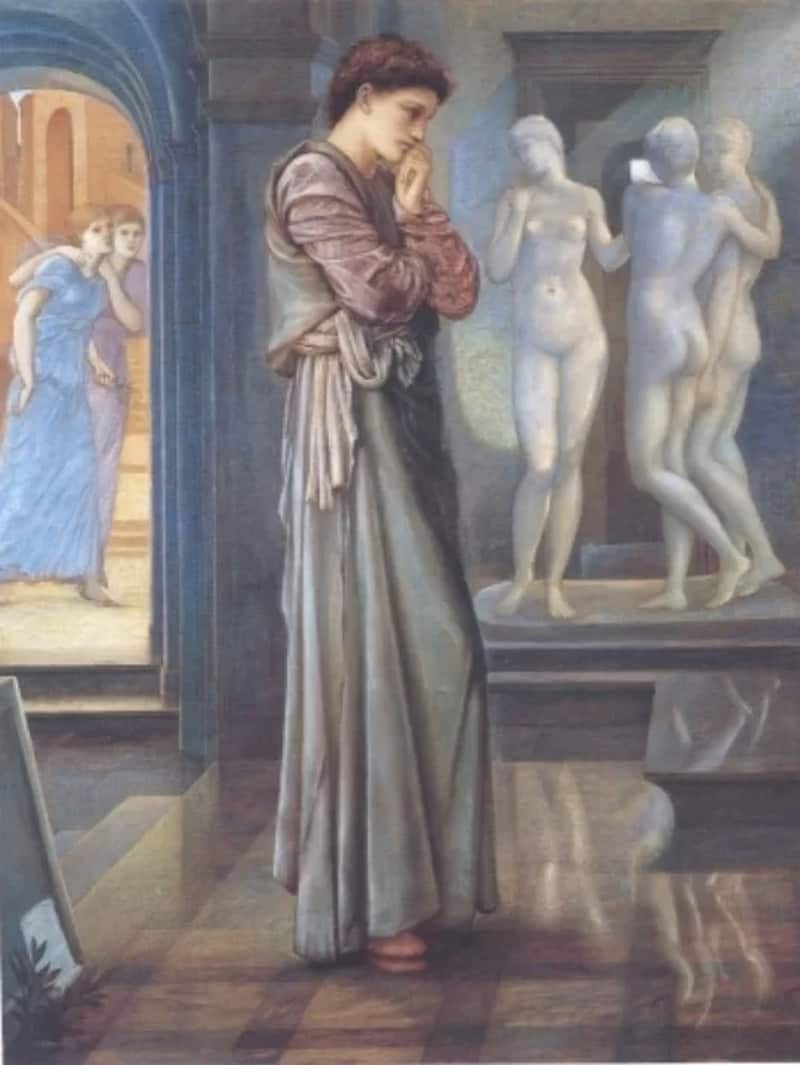
In this first depiction you can see Pygmalion looking down, with a lot on his mind. He is clearly disgusted by the depraved lifestyle that the women around him showcased, he can’t even look at them anymore because of how appalled he is by them.
From this moment on he would stay celibate and live his whole life trying to improve his craft, and he decides to start off by carving the very thing that hurt him in the first place, aka a woman.
You can even see him ignoring all of the women staying outside of his doorway as they gawk at him, trying to get his attention.
On the right side you can see a few statues that he had carved in the past. Since there are three of them, many scholars believe that they may be a representation of the Three Graces.
The reason as to why he is incapable of even noticing the women peering through though is because he has set his mind on the perfect woman, and he is now trying to collect his thoughts to accurately portray her through his craft.
Pygmalion and Galatea II: The Hand Refrains
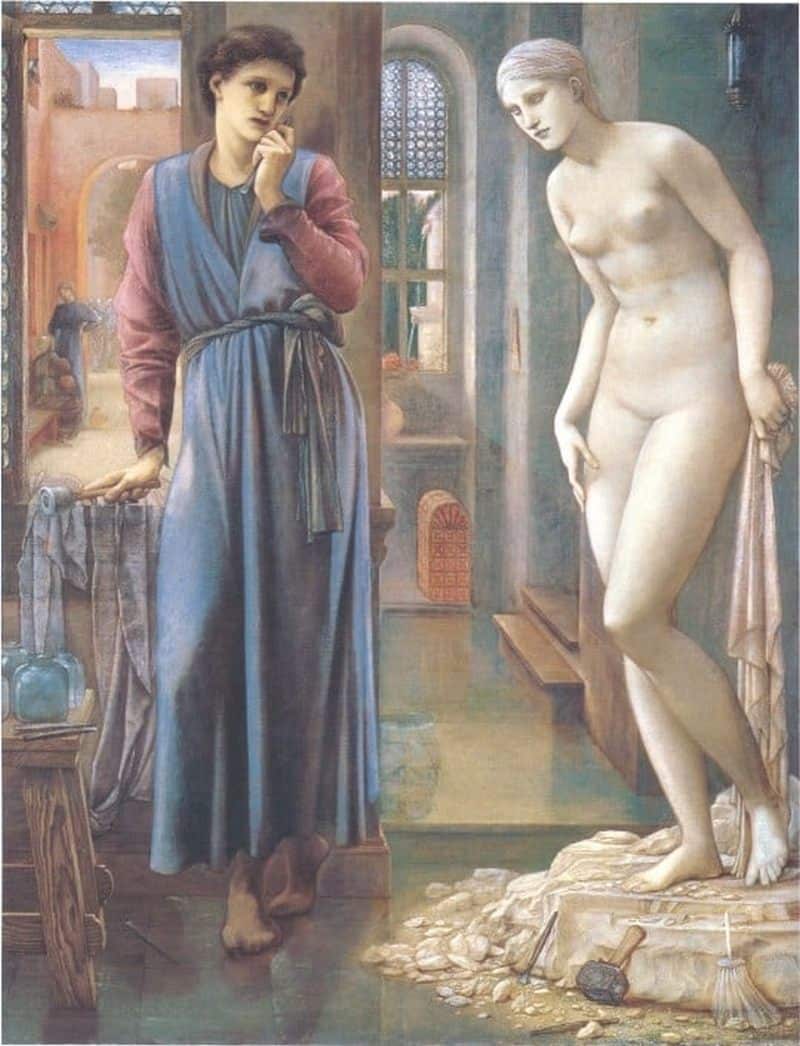
In this showcase we can see the fact that Pygmalion has officially completed his creation. Despite this though, his face does not seem to show any joy or pride, instead he falls back a bit, being taken by surprise by just how beautiful she is.
From this moment on he would fall in love with his statue, even going as far as to name her Galatea. The meaning behind it is also quite beautiful, as it directly translates to “she who is white as milk”.
After this he would spend all of his time staring at her, being in complete awe of his creation, knowing that no real woman could ever rise to his expectations now that he knew what perfection looked like.
We can also see several interesting tools and instruments thrown in front of Galatea’s statue, which implies that he worked in a hurry trying to capture the image that he had in his mind, which is why he couldn’t get a good look at her until he was done.
The soft brush that we can see next to her body is also an interesting detail, as it implies that even though he was in a hurry, he would still spend extra time trying to perfect his work by removing any and all dust off of her to make sure that she was perfect to the most minute detail.
Pygmalion and Galatea III: The Godhead Fires
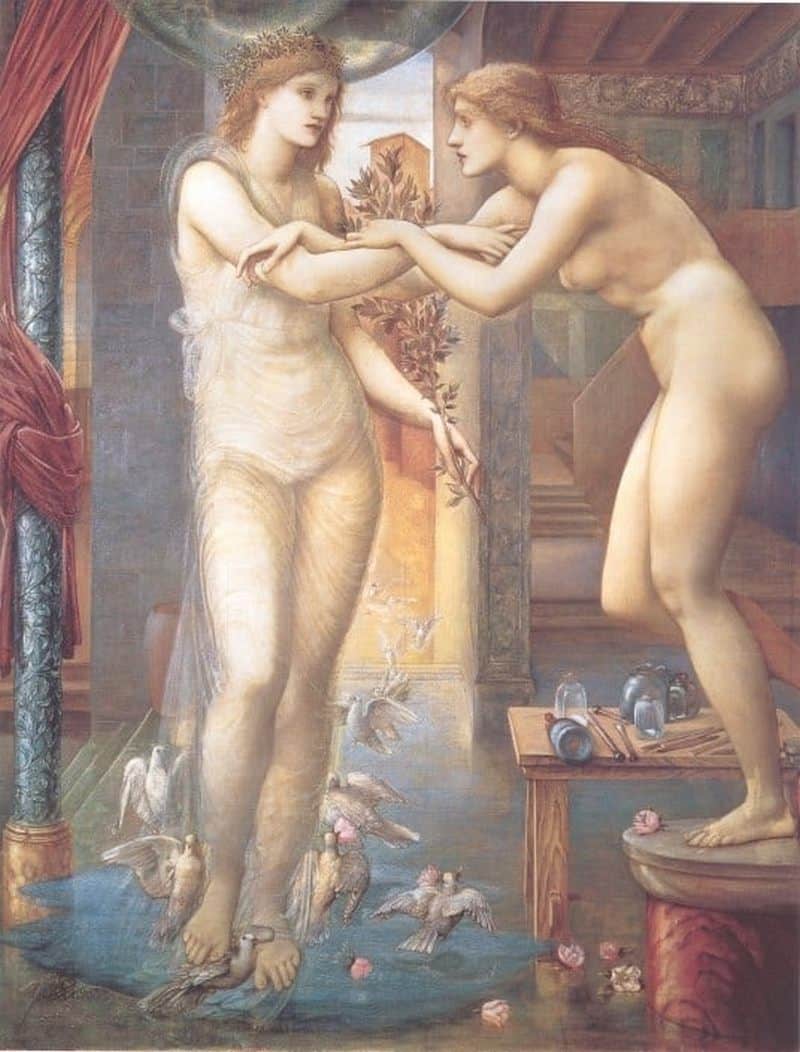
As the city is celebrating the festival of Aphrodite though, Pygmalion instead retreats to his studio, where he makes his offerings to the Goddess of Love.
In this interpretation, it seems as though he begs the Goddess to bring her to life, which is different from the original depiction which had Pygmalion offer up his heart and soul to the Goddess in exchange for someone in the statue’s likeness.
But even so, Aphrodite listens to his veneration, and in exchange for his continuous service in her name, she decides to pay him a visit.
You can see her here, as she looks upon the statue. After seeing it, she can’t help but be amazed by her beauty, to the point where even she is said to have fallen in love with it.
Understanding his feelings from this moment on, Aphrodite decides to grant the artist his wish, bringing her to life. You can see the statue grasping the Goddess’s hands, trying to hold herself up so she doesn’t fall down.
Since she is the Goddess of Love and subsequently of Beauty, she is depicted here with a puddle underneath her feet out of which life springs out.
Pygmalion and Galatea IV: The Soul Attains

As soon as Pygmalion comes home, he can see the difference in Galatea’s face, since he had spent all of those nights just looking at her beauty endlessly. He can see the flush on the cheeks, and instantly falls to his knees in front of her.
That is when he sees her move, and he realizes the fact that his prayed had been heard, and that the Goddess of Love decided to finally give him what he had asked for since he created Galatea.
He embraces her, after which Galatea completely turns from a cold marble construction to a real human being. This is to show that while she did give her life, she did not yet give her a soul.
The only way for the statue to become a real human being would have been for Pygmalion to show her what true love meant, and he did so successfully from the moment he laid his eyes upon her.
The two would end up getting married soon after, and thanks to the blessings of Goddess Aphrodite, the two would live happily ever after. They even ended up with a son named Paphos, after which a city in Cyprus was named.
This is where the story ends, but since it was such a popular tale, it wasn’t the only time that Burne-Jones would showcase his artistic style depicting it.
In fact, he actually published two series of oil paintings illustrating the story, with the first being officially released from1868 to 1870. They had monochromatic tones and rigid forms, but even so they’re still considered to be amongst the artist’s best works.
This was done as an homage to his friend and mentor Dante Gabriel Rossetti, but he would not be too happy with his work, eventually remaking it in his second series.
This second series was displayed above, and it was published between 1875 and 1878. It features a much more familiar style which Burne-Jones was pretty much one of the best at, which is why he was much happier with the result here.
The Question of Sexual Morality
The story is meant to serve as a warning to women that wish to display their immorality openly, as this would imply that they would no longer be seen as suitable matches for the young men back in Ancient Greece.
This is why Pygmalion is often times cited as a perfect depiction of the everyday young man, he is a hard worker but he also doesn’t mind spending his time outside enjoying himself.
He is very good at what he does and he takes pride in it, and when he sees the women around him acting out their fantasies in front of everyone, he is disgusted and he ends up looking away.
Instead of just giving up his morality he decides to create his depiction of the perfect woman using his talent, and so he essentially creates Galatea, the woman of his dreams.
Immediately he falls in love with her beauty, but in itself, this beauty would not amount to much if she were to be as immoral as the Propoitides for example.
The purity that she displays can still be achieved by women around, even if they don’t share the same beauty as Galatea has.
In order to prove the fact that he truly loves her, Pygmalion decides to marry her on the spot, thus showcasing the fact that he does not care about anything but beauty and purity, which Galatea had plenty of.
In some depictions, during the festival he comes back to his place and he touches the statue passionately. This passion brings life to wherever he touches, which is why he continues to touch and caress her ever part.
In this depiction, it is said that Venus, or Aphrodite, showed up there herself in order to marry the two. She gave the statue life, but it was only through his display of passion and true love that the statue could come to life.
Conclusion
There are always going to be critics with every story around, and the tale of Pygmalion and Galatea is no different.
There have been a lot of critics over the years for example that bring about the fact that despite the fact that he could not stand the idea of women being sexual in public, Pygmalion had no problem with displaying his sexual attraction to Galatea in his own studio.
Regardless, we won’t dive too deep into that mindset, and instead we’ll just refer to this as such: It is a beautiful story of dreams coming true and of an artist that fell in love with his work.
It is actually quite common to hear that artists would fall in love with their art, which is why this story lasted for so long. After all, “beauty is in the eye of the beholder”, so in his quest to create the perfect woman, how could Pygmalion avoid falling in love with his own depiction of the perfect partner?







